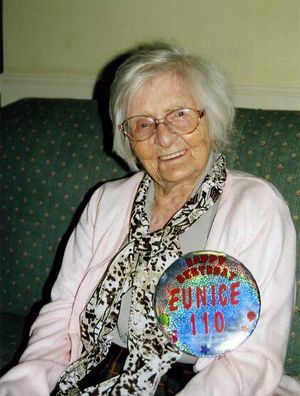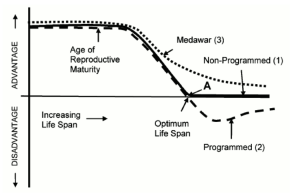Theories of Ageing
Online Course: Parkinson’s Programme
Online Course: Sleep Programme
Online Course: Atypical Presentation of COVID in the Elderly
Biological Ageing

Most people will live to experience aging. Age-related deterioration is affecting an ever-growing number of people. Although the process is unavoidable, it is important to understand the process. As a physiotherapist, we might be able to positively influence aspects that maintain or engender better health and wellness as a person ages, treating and ameliorating symptoms of common conditions associated with aging.
In the past, maximum life span (the maximum biological limit of life in an ideal environment) was not thought to be subject to change with the process of aging considered non-adaptive, and subject to genetic traits. In the early 1900s, a series of flawed experiments by researcher Alexis Carrel demonstrated that in an optimal environment, cells of higher organisms (chickens) were able to divide continually, leading people to believe our cells to potentially possess immortal properties. In the 1960’s Leonard Hayflick[1] disproved this theory by identifying a maximal number of divisions a human cell could undergo in culture (known as the Hayflick limit), which set our maximal life span at around 115 years. Life span is the key to the intrinsic biological causes of aging, as these factors ensure an individual’s survival to a certain point until biological aging eventually causes death.
There are many theories about the mechanisms of age-related changes, and they are mutually exclusive, no one theory is sufficiently able to explain the process of aging, and they often contradict one another. A literature review[2] highlights that centenarians have healthy ageing because of the delay in processes like physiological decline and age-related diseases or syndromes. The review discusses that genetic component which plays an important role in longevity. The researchers suggest that biology of centenarians yields a key for intervention to promote healthy ageing in the general population.
Modern biological theories of aging in humans currently fall into two main categories: programmed and damage or error theories.
The programmed theories imply that aging follows a biological timetable (regulated by changes in gene expression that affect the systems responsible for maintenance, repair and defense responses), and the damage or error theories emphasize environmental assaults to living organisms that induce cumulative damage at various levels as the cause of aging[3].
These two categories of theory[4] are also referred to as non-programmed aging theories based on evolutionary concepts (where ageing is considered the result of an organism’s inability to better combat natural deteriorative processes), and programmed ageing theories (which consider ageing to ultimately be the result of a biological mechanism or programme that purposely causes or allows deterioration and death in order to obtain a direct evolutionary benefit achieved by limiting lifespan beyond a species-specific optimum lifespan (Figure 1).

Figure 1: Evolutionary cost/ benefit of additional lifespan vs. age.
Curve 1: Modern non-programmed aging theories – The evolutionary value of further life and reproduction is effectively zero beyond some species-specific age.
Curve 2: Modern programmed aging theories – There is an evolutionary cost associated with surviving beyond a species-specific age.
Curve 3: Medawar’s concept – The evolutionary value of survival and reproduction declines with age following a species-specific age[4].
Goldsmith's review of modern programmed (adaptive) theories of biological ageing investigates how organisms have evolved mechanisms that purposely limit their lifespans in order to obtain an evolutionary benefit.
Theories of Ageing
This video gives a good introduction to the theories of aging
[5]
In his review of the modern theories of ageing, Jin[3] highlights three sub-categories of the programmed theory, and four sub-categories of the damage or error theory, and also relates some to how these might be observed in ageing populations.
The Programmed Theory
1) Programmed Longevity, which considers ageing to be the result of a sequential switching on and off of certain genes, with senescence being defined as the time when age-associated deficits are manifested.
2) Endocrine Theory, where biological clocks act through hormones to control the pace of ageing.
3) Immunological Theory, which states that the immune system is programmed to decline over time, leading to an increased vulnerability to infectious disease and thus ageing and death.
The Damage or Error Theory
1) Wear and tear theory, where vital parts in our cells and tissues wear out resulting in ageing.
2) Rate of living theory, that supports the theory that the greater an organism's rate of oxygen basal, metabolism, the shorter its life span
3) Cross-linking theory, according to which an accumulation of cross-linked proteins damages cells and tissues, slowing down bodily processes and thus result in ageing.
4) Free radicals theory, which proposes that superoxide and other free radicals cause damage to the macromolecular components of the cell, giving rise to accumulated damage causing cells, and eventually organs, to stop functioning.
Further Theories
Trindade et al[6] provide a different viewpoint again, stating that to understand the evolution of ageing, we have to understand the environment-dependent balance between the advantages and disadvantages of extended lifespan in the process of spreading genes. These researchers have developed a fitness-based framework in which they categorise existing theories into four basic types: secondary (beneficial), maladaptive (neutral), assisted death (detrimental), and senemorphic aging (varying between beneficial to detrimental).
Some of the more commonly discussed theories and their relation to ageing are summarised below:
Disengagement Theory[7]
Refers to an inevitable process in which many of the relationships between a person and other members of society are severed & those remaining are altered in quality.
Withdrawal may be initiated by the ageing person or by society, and may be partial or total.
It was observed that older people are less involved with life than they were as younger adults.
As people age they experience greater distance from society & they develop new types of relationships with society.
In America there is evidence that society forces withdrawal on older people whether or not they want it.
Some suggest that this theory does not consider the large number of older people who do not withdraw from society.
This theory is recognised as the first formal theory that attempted to explain the process of growing older.
Activity Theory[8]
Is another theory that describes the psychosocial ageing process.
Activity theory emphasises the importance of ongoing social activity.
This theory suggests that a person's self-concept is related to the roles held by that person i.e. retiring may not be so harmful if the person actively maintains other roles, such as familial roles, recreational roles, volunteer & community roles.
To maintain a positive sense of self the person must substitute new roles for those that are lost because of age. And studies show that the type of activity does matter, just as it does with younger people.
The Neuroendocrine Theory[9][10]
First proposed by Professor Vladimir Dilman and Ward Dean MD, this theory elaborates on wear and tear by focusing on the neuroendocrine system.
This system is a complicated network of biochemicals that govern the release of hormones which are altered by the walnut sized gland called the hypothalamus located in the brain.
The hypothalamus controls various chain-reactions to instruct other organs and glands to release their hormones etc. The hypothalamus also responds to the body hormone levels as a guide to the overall hormonal activity. But as we grow older the hypothalamus loses it precision regulatory ability and the receptors which uptake individual hormones become less sensitive to them. Accordingly, as we age the secretion of many hormones declines and their effectiveness (compared unit to unit) is also reduced due to the receptors down-grading
The Free Radical Theory[9]
This now very famous theory of aging was developed[11] by Denham Harman MD at the University of Nebraska in 1956. The term free radical describes any molecule that has a free electron, and this property makes it react with healthy molecules in a destructive way.
Because the free radical molecule has an extra electron it creates an extra negative charge. This unbalanced energy makes the free radical bind itself to another balanced molecule as it tries to steal electrons. In so doing, the balanced molecule becomes unbalanced and thus a free radical itself.
It is known that diet, lifestyle, drugs (e.g. tobacco and alcohol) and radiation etc., are all accelerators of free radical production within the body.
The Membrane Theory of Aging
The membrane theory of aging was first described[12] by Professor Imre Zs.-Nagy of Debrechen University, Hungary. According to this theory it is the age-related changes of the cell's ability to transfer chemicals, heat and electrical processes that impair it.
As we grow older the cell membrane becomes less lipid (less watery and more solid). This impedes its efficiency to conduct normal function and in particular there is a toxic accumulation
The [9] Decline Theory[9]
The mitochondria are the power producing organelles found in every cell of every organ. Their primary job is to create Adenosine Triphosphate (ATP) and they do so in the various energy cycles that involve nutrients such as Acetyl-L-Carnitine, CoQ10 (Idebenone), NADH and some B vitamins etc.
Enhancement and protection of the mitochondria is an essential part of preventing and slowing aging. Enhancement can be achieved with the above mention nutrients, as well as ATP supplements themselves
The Cross-Linking Theory[13]
The Cross-Linking Theory of Aging is also referred to as the Glycosylation Theory of Aging. In this theory it is the binding of glucose (simple sugars) to protein, (a process that occurs under the presence of oxygen) that causes various problems.
Once this binding has occurred the protein becomes impaired and is unable to perform as efficiently. Living a longer life is going to lead to the increased possibility of oxygen meeting glucose and protein and known cross-linking disorders include senile cataract and the appearance of tough, leathery and yellow skin.
Further information on video
In addition to these explanations, you can see several presentations about the biological theories of ageing on YouTube:
The Wear and Tear Theory:
The ageing Academy’s series on Aging: Stem Cells, long Lived Proteins, Cell Programming, Gene Expression:
A Big Think monologue by Michio Kaku looking at what enzymes like Telomerase and Resveratrol offer:
[14]
See also - Policy and Initiatives Focused on the Older Population
Parkinson’s Programme
A programme of online courses by Bhanu Ramaswamy
References
↑ Hayflick L. Theories of biological aging. Experimental Gerontology. 1985; 20:145-159. Accessed 25 September 2018.
↑ Borras C, Ingles M, Mas-Bargues C, Dromant M, Sanz-Ros J, Román-Domínguez A, Mallench-Gimeno L, Gambini J, Viña J. Centenarians: An excellent example of resilience for successful ageing. Mechanisms of Ageing and Development. 2019 Dec 31:111199.
↑ Jump up to:3.0 3.1 Jin K. Modern biological theories of ageing. Aging Dis. 2010; 1(2): 72–74. Accessed 25 September 2018.
↑ Jump up to:4.0 4.1 Goldsmith TC. Modern evolutionary mechanics theories and resolving the programmed/non-programmed aging controversy. Biochemistry (Mosc). 2014; 79 (10): 1049 - 55.
↑ Piled higher and deeper. Theories if ageing Available from: https://www.youtube.com/watch?v=jc4yK0zZ-cQ (last accessed 23.5.2019)
↑ Trindade LS, Aigaki T, Peixoto AA. A novel classification system for evolutionary aging theories. Front Genet. 2013; 6 (4): 25. Accessed 25 September 2018.
↑ Achenbaum WA, Bengtson VL. Re-engaging the Disengagement Theory of Aging: on the history and assessment of theory. Development in Gerontology. Gerontologist. 1994; 34(6): 756–763.
↑ Diggs J. Activity Theory of Aging. In: Loue S.J., Sajatovic M. (eds) Encyclopedia of Aging and Public Health. Springer, Boston, 2008.
↑ Jump up to:9.0 9.1 9.2 9.3 Weinert BT, Timiras PS. Invited review: theories of aging. Appl Physiol. 2003; 95: 1706–1716. Accessed 25 September.
↑ Dean W. Neuroendocrine Theory of Aging: Chapter 2 Adaptive Homeostat Dysfunction. Accessed 25 September 2018 fromhttps://warddeanmd.com/articles/neuroendocrine-theory-of-aging-chapter-2/
↑ Harman, D. Aging: a theory based on free radical and radiation chemistry. J Gerontol. 1956;11 (3): 298–300.
↑ Zs.-Nagy I. The Membrane Hypothesis of Aging. Florida: CRC Press, 1994.
↑ Zs.-Nagy I, Nagy K. On the role of cross-linking of cellular proteins in aging. Mech Ageing Dev. 1980; 14 (1–2): 245-251.
↑ Big ThinkMichio Kaku: How to Reverse Aging | Big Think Available fromhttps://www.youtube.com/watch?v=DV3XjqW_xgU&feature=emb_logo
